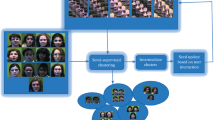Abstract
A method for the semi-automatic collection of samples for learning face identification algorithms is proposed. In the experimental evaluation, the operation of the face identification algorithm on ethnically diverse data is considered. The algorithm operation is also evaluated on the data with a wide variation of ages. The proposed method makes it possible to expand the training sample by indexing new data.




Similar content being viewed by others
REFERENCES
Yi, D. et al., Learning face representation from scratch, 2014. arXiv:1411.7923
Wang, F. et al., Additive margin softmax for face verification, IEEE Signal Proc. Lett., 2018, vol. 25, no. 7, pp. 926–930.
Gao, W. et al., The CAS-PEAL large-scale Chinese face database and baseline evaluations, IEEE Trans. Syst., Man, Cybernetics, Part A: Syst. Humans, 2008, vol. 38, no. 1, pp. 149–161.
Guo, Y. et al., MS-Celeb-1M: A dataset and benchmark for large-scale face recognition, European Conference on Computer Vision, 2016, pp. 87–102.
Maze, B. et al., IARPA Janus benchmark–C: Face dataset and protocol, 11th IAPR International Conference on Biometrics, 2018.
Sun, Y., Wang, X., and Tang, X., Deep learning face representation from predicting 10,000 classes, Proc. of the IEEE conference on computer vision and pattern recognition, 2014, pp. 1891–1898.
Phillips, P.J. et al., The FERET database and evaluation procedure for face-recognition algorithms, Image Vision Comput., 1998, vol. 16, no. 5, pp. 295–306.
Schroff, F., Kalenichenko, D., and Philbin, J., Facenet: A unified embedding for face recognition and clustering, Proc. of the IEEE Conference on Computer Vision and Pattern Recognition, 2015, pp. 815–823.
Taigman, Y. et al., Deepface: Closing the gap to human-level performance in face verification, Proc. of the IEEE Conference on Computer Vision and Pattern Recognition, 2014, pp. 1701–1708.
Sun, Y. et al., Deepid3: Face recognition with very deep neural networks, 2015. arXiv:1502.00873
He, K. et al., Deep residual learning for image recognition, Proc. of the IEEE conference on computer vision and pattern recognition, 2016, pp. 770–778.
Author information
Authors and Affiliations
Corresponding authors
Additional information
Translated by A. Klimontovich
Rights and permissions
About this article
Cite this article
Bagrov, N.Y., Konushin, A.S. & Konushin, V.S. A Semi-Automatic Method of Collecting Samples for Learning a Face Identification Algorithm. Program Comput Soft 45, 133–139 (2019). https://doi.org/10.1134/S0361768819030022
Received:
Revised:
Accepted:
Published:
Issue Date:
DOI: https://doi.org/10.1134/S0361768819030022




